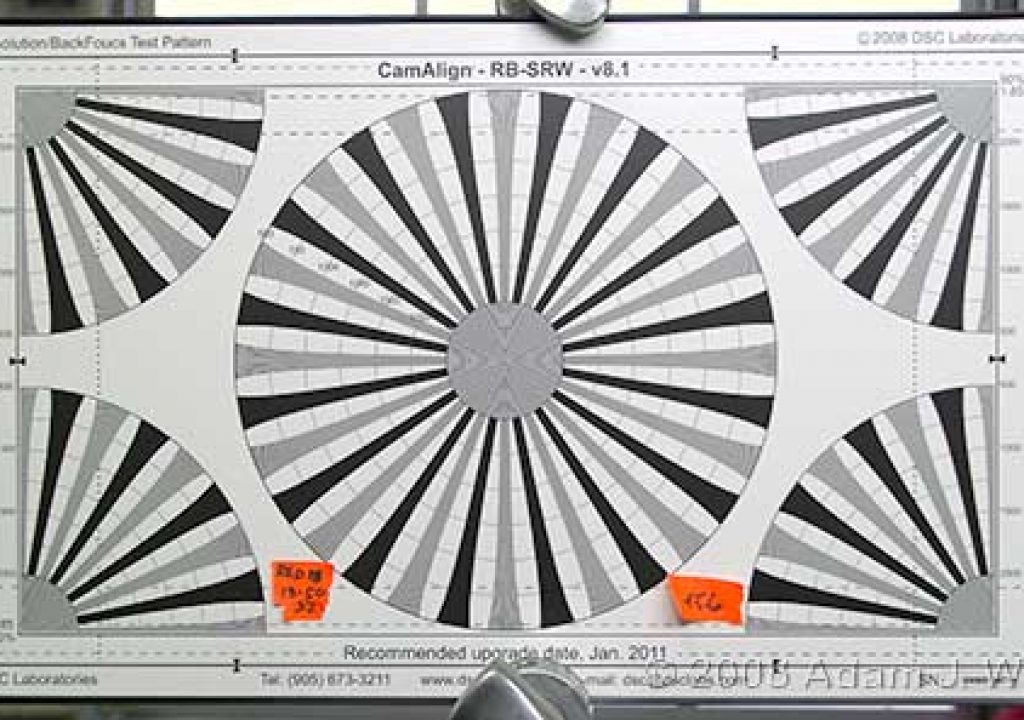I obtained a new, 4K resolution test chart at NAB, and aimed RED ONEs running build 15 version 2.2.5 at it using four different lenses: a 50mm Super Speed, a 50mm Ultra Prime, a 18-50mm RED zoom, and a 24-290mm Optimo. Cutting to the chase: I’m pleased to report that I see detail extinction at about 3.2K, confirming the numbers RED and others have claimed.
In a couple of previous tests (including the unfair 3-camera comparison, I’d come to the tentative conclusion that I could see detail out to about 2.4K – 2.5K, measured as distinct lines of detail across the image width (in video cameras, it’s normal to talk about “TV lines per picture height”, not lines per picture width; in film and in traditional optical engineering, one normally discusses “cycles” or “line pairs”, where two discernible lines, or a full alternation from dark to light, are taken together. Film scanning and digital cine cameras measure resolvable detail by the number of discrete lines across the image width, so I’ll use this metric for digital cine cameras like RED’s). These previous tests were done with a discrete-frequency chart, the DSC Labs Cam-Align MBSQ-SW v.4.1, showing blocks of lines at 50, 100, 200, 400, 600, 800, 1000, and 1200 TVl/ph. Shot full-height with RED at 4k 2:1, the chart could show me detail at 2000 and 2400 lines per picture width (at 2:1 aspect ratio, the width numbers are twice the height numbers), but couldn’t say anything about higher resolutions.
I tried reframing at half the picture height, thus effectively doubling the resolution of the chart; the chart’s 600 and 800 TVl/ph blocks translated to 2400 and 3200 lines per picture width (or 2.4K and 3.2K in digital cine terms; I’m ignoring the 2.4% difference between 1K=1000 and 1K=1024 in this and in the discussion that follows). I saw a bit of detail at 2.4k and undifferentiated gray at 3.2k, so I conservatively pegged the RED ONE’s resolution at “2.4k+, probably between 2.4k and 2.5k.”
But there’s a big, unexplored gap between 2.4K and 3.2K, and one test with one lens (an 18mm SuperSpeed at a fairly wide aperture) isn’t conclusive, especially when RED’s Graeme Nattress and cinematographer Guy-Louis Mier both claim to have seen the camera reach out to 3.2K. I get annoyed when numbers don’t match, so I resolved (pun intended, and no, it won’t be the last time) to test things further: I’d find a chart that unambiguously swept the frequencies of interest out to at least 3.2k, and I’d try several lenses and run through a range of T-stops on each one, to be sure I found each one’s “sweet spot” for maximum detail.
The Chart
At NAB, I went to the DSC Labs booth to see what they had. As it turns out, DSC had just produced their first digital cinema resolution chart, of which they had four copies, and they retrieved one of them from the Iconix booth for me.
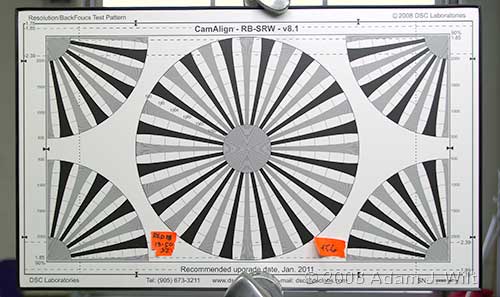
the DSC Labs RB-SRW v8.1
This chart has several notable features:
- 29-line (15 black lines separated by 14 white lines) resolution trumpets: enough lines to easily see when aliasing comes into play.
- Trumpets range from 500-2000 TVl/ph, enough to measure out to 4k when framed full height at 2:1 aspect ratio.
- 16 trumpets around the center circle: one every 22.5 degrees, so one can see horizontal, vertical, and several diagonal resolutions.
- Quarter-circles in the corners, to measure edge sharpness as well as center sharpness.
(No, you won’t find the RB-SRW on the DSC Labs site just yet. Part of my intent on visiting DSC at NAB was to complain about their website, especially when it came to choosing resolution charts: I had really wanted a frequency sweep chart instead of the discrete-frequency chart I wound up with for the Texas Shootout. But the DSC folks, being calm, affable Canadians, simply agreed, saying, “well, the website’s not so good, eh?” DSC’s Michael Weigand then pulled out an MB-SW v4.1 chart—the frequency-sweep counterpart to the discrete-frequency MBSQ-SW chart I already have—and sold to to me with a nice show discount, in addition to the RB-SRW chart. Moral of the story? See the DSC Labs folks at trade shows or call ’em up if you have questions; they are friendly and approachable. According to Michael, the RB-SRW appears on their price list as the DCR [“Digital Cinema Resolution”], and the SRW size is US$792.)
The Lenses
At Videofax in San Francisco, I used the Zeiss 50mm Super Speed and the Zeiss 50mm Ultra Prime.
At Chater Camera in Berkely I tested the RED 18-50mm and the 12x Angeneiux Optimo 24-290mm.
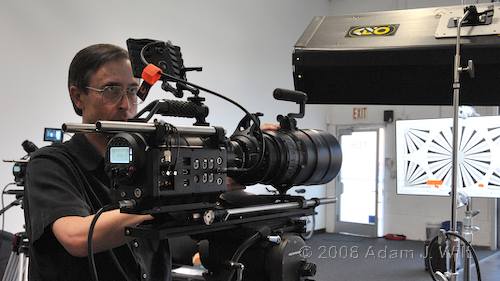
Now that’s a lens… and they say size doesn’t matter! (Photo: Tim Blackmore)
Many thanks to both rental houses for the opportunity.
Next: lens specifics, RED resolution tests…
I shot with each lens from wide-open down to a small aperture: T16 on the primes, T8 on the zooms. I left the cameras at ISO 320 and varied shutter speed to keep exposure consistent. I used RGB histograms and “traffic lights” on the RED LCD to set exposure; I kept all channels just below clipping.
Each lens was focused wide open at the shooting focal length. To focus, I used both the LCD’s “full screen” mode and the image mag button on the RED body (assignable button 2). I had to focus the way I do with digital still cameras lacking optical finders: by repeatedly racking through what seems to be the best focus (usually determined more by the appearance of aliasing on fine detail than by any visible detail itself), noting where on the lens scale the focus appeared to be, then picking the average of the various results. The RED LCD is simply too coarse to focus precisely with, and even the 720p monitor output doesn’t show you anything close to the detail you need to see for accurate focusing.
Even so, I blew focus on a couple of tests; I viewed the first UltraPrime test in REDCINE on-site and was able to redo it, but a couple of focal lengths with the 18-50mm turned out to be unusable, and I didn’t catch that at the time. They were sharp in the LCD, and sharp on the 720p output, but the 4K images viewed 1:1 in REDCINE showed that either that lens goes uncharacteristically soft, or I had missed my focus.
Lens Details
All lenses managed to resolve 3.2K or greater; the sensor is the limiting factor in these tests more than the lenses are. As you’ll see below, the RED aliases detail on 45 degree diagonals, and all lenses showed aliasing out to the full 2000 TVl/ph / 4K resolution of the chart—so the lenses are all clearly capable of delivering 4K of detail.
Even wide open I saw the same fine detail, though often at lower contrast levels (the real measure of sharpness is the contrast throughout the range of resolved detail frequencies, not merely the limiting resolution).
Resolution started falling off between T5.6 and T8 on all the lenses as diffraction sets in at the smaller apertures: for optimum sharpness and ultimate detail, shoot the RED ONE with apertures of T5.6 or wider.
50mm Ultra Prime
What a lens! It’s as crisp and contrasty wide open (T1.9) as it was at T4 or T5.6: the detailed images below are from the 50mm Ultra Prime @ T1.9. No chromatic aberration, no distortion either. Sweet!
50mm Super Speed
The Super Speed was just as sharp as the Ultra Prime from T4 onwards, but at wider apertures (up to T1.3) it showed increasing flare and halation, which reduced its contrast and contributed to the “soapy” look we saw in the depth-of-field comparison of the EX1, F23, and RED ONE.
18-50mm RED zoom
This lens did surprisingly well at 18mm, with high resolution. Fully wide (T3) it’s visibly less sharp, as contrast is lowered and flare is more visible, but the limiting resolution holds up and aliasing is seen nearly to 4K. The lens is crisper at T4 and crisper still at T5.6, which appears to be its sweet spot.
It has a bit of green/magenta chromatic aberration at 18mm: about a pixel or two of fringing appeared at the outer edges of the chart. It’s worse in this regard compared to the primes, but compared to most under-$10K video camera lenses, and even some high-end HD ENG/EFP zooms, it’s not bad at all. Fully wide, there’s a bit of barrel distortion: noticeable, but not unusably bad.
At 32mm and at 50mm, the distortion was gone. Chromatic aberration diminished as the lens zoomed in, being barely observable at 32mm and entirely absent at 50mm.
Unfortunately, I can’t judge the sharpness of this lens at either 32mm or 50mm; my captured images are quite soft, with a limiting resolution of maybe 2.7K and no visible aliasing on the diagonals even at T5.6. Either this lens is unusually poor at those focal lengths, or (as is more likely) I simply didn’t get the focus right to begin with. As we found in repeated tests at Chater (more on this in a follow-on article), neither the RED’s LCD nor its monitoring output have the detail necessary to nail focus precisely, even with image enlargement engaged.
Two other notes:
The mechanical feel of the 18-50mm is very rough, almost as if the zoom, focus, and iris rings were unlubricated, metal-on-metal sliders. It grinds like a Cooke, only more so. My partner Tim, after using the 18-50mm both at Chater and at NAB, told me flat out: “We are not getting that lens!”
After shooting the chart at 50mm with the RED lens, I swapped in the Optimo, but found I had to zoom the Optimo out to 40mm to see the same amount of chart. We also compared the Optimo at 50mm to a 50mm Ultra Prime, and they both showed the same angle of view. Based in this quick test (and no, we didn’t pursue it further, for lack of time), it appears that the 50mm end of the 18-50mm is more like 40mm. I will look into this further the next time I have a chance.
12x Optimo 24-290mm
At 12x, this lens is a “super-zoom”, and expecting it to perform as well as a prime or a shorter-range zoom is unrealistic. It did pretty darned well for a super-zoom.
I only tested this lens at 24mm and at 40mm due to time constraints, but informal zooming as well as captured footage playing back at Chater (a long zoom-out of Angel Falls in Yosemite) indicated that the lens continues to perform admirably at longer focal lengths.
At 24x it has noticeable barrel distortion and a slight bit of chromatic aberration; at 40x it’s a bit pincushioned and the CA is almost gone. A zooming shot shows no CA at tighter focal lengths, either.
Sharpness is excellent at both 24mm and 40mm. The lens resolves well at its widest aperture of T2.8, but the lens crispens up at T4 and stays crisp down through diffraction-limited T-stops. T2.8 isn’t bad; it’s just not quite as contrasty as it is at T4 or smaller.
RED Resolution Details
Stills were pulled as TIFFs using REDCINE build 90, using Sharpen: 100.00, Detail: High, NR: Enabled. Varying these settings changed the contrast of the fine detail, but did not change the basic underlying image; using lower detail and sharpen settings didn’t change the frequencies at which detail appeared, only the visibility of it at those frequencies. The NR setting did make a difference: it reduces red & blue chroma aliasing considerably without harming luma detail:
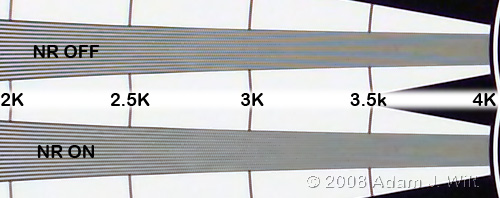
Effect of the NR setting; resolution numbers based on lines per picture width
Both this image and the following one were slightly contrast-enhanced in Photoshop to improve visibility, but no important scene detail has been lost. These images were saved as JPEGs with quality 80 to avoid adding any significant artifacts or degradation; sorry about the resulting long load times. Images are 1:1 extracts from the full 4096×2048 frame, which was shot filling the height of the 2:1 picture, so the resolution numbers printed on the chart (TV lines / picture height) can be doubled for digital cine metrics.
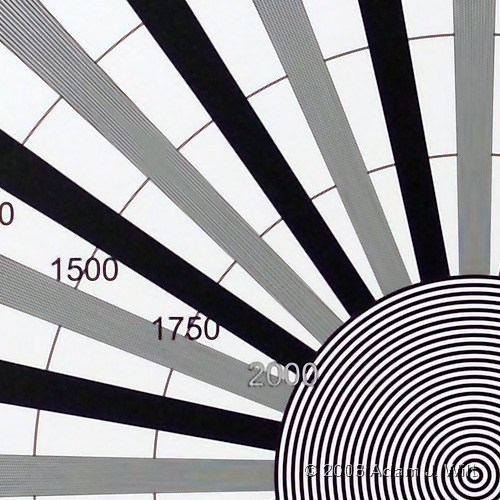
Detail of resolution chart, NR on, RED ONE 4K 2:1 using 50mm UltraPrime @ T1.9
My observations (feel free to disagree in the comments!):
- Detail extinction occurs horizontally & vertically at about 3.2K, maybe even a bit more horizontally, with minimal and unobjectionable chroma aliasing at higher frequencies.
- At +/- 22.5 degrees off-axis, there’s stronger detail almost out to 3.4k, though aliasing is starting to set in by around 2.7K.
- At 45 degree angles, fine details are starting to alias from about 2K onwards, but aliasing continues strongly out to the 4K point.
[Note that my conclusions are based on looking at dozens of frames; the 500×500 pixel extract shown above can’t show all the variations of aliasing as the camera is moved across the test chart, nor all the variations of the individual lenses and T-stops.]
The difference in performance depending on angle is not surprising; Bayer-mask sampling is sharper diagonally in the green channel than in H & V (as Larry Thorpe shows in part six of Demystifying Digital Camera Specifications; I might quibble about some of the numbers and definitions in this preso, but in general it’s a good intro to the topic and the tradeoffs involved), and also has more aliasing diagonally.
I might not want to use the RED ONE for shooting a chain-link fence receding into the distance—or other pathologically fine diagonal details—but many other cameras will fail this test just as badly. The aliasing from the RED’s Mysterium sensor as processed through REDCINE is among the least objectionable I’ve seen; most three-chip cameras are worse in this regard: the RED team has made sensible tradeoffs between sharpness and artifacts in their debayering algorithms. Furthermore, most of the sharp-edged fine detail we see in typical images is closer to horizontal or vertical than to the diagonals. Taking the point where the detail vanishes in both H & V directions, I’d call the camera a 3.2K camera—which, I’m happy to report, is the same figure quoted by Graeme Nattress.
Fine, it’s 3.2K, so what’s the big deal?
- For a 2K or HD production, shooting in 4K gives you an honest 3K to work with, allowing considerable resizing and repositioning in post, and providing a nice amount of “resolution headroom” for compositing purposes.
- The reasoning behind the Epic’s 5K sensor becomes clear: If a 4K sensor like the Mysterium yields 3.2K lines of resolution, that’s about 80% “spatial efficiency” (78% if you want to get picky about it). If the Epic’s 5K sensor works the same way, then it should resolve about 4K, allowing Epic shooters to say they’re working with a true 4K system with a reasonably straight face (grin).
- Personally, the big deal is that my numbers now agree with the other numbers I’ve seen for RED’s resolution. Having a different measurement makes me nervous; so I’m pleased to now concur with other folks on this issue.

Filmtools
Filmmakers go-to destination for pre-production, production & post production equipment!
Shop Now